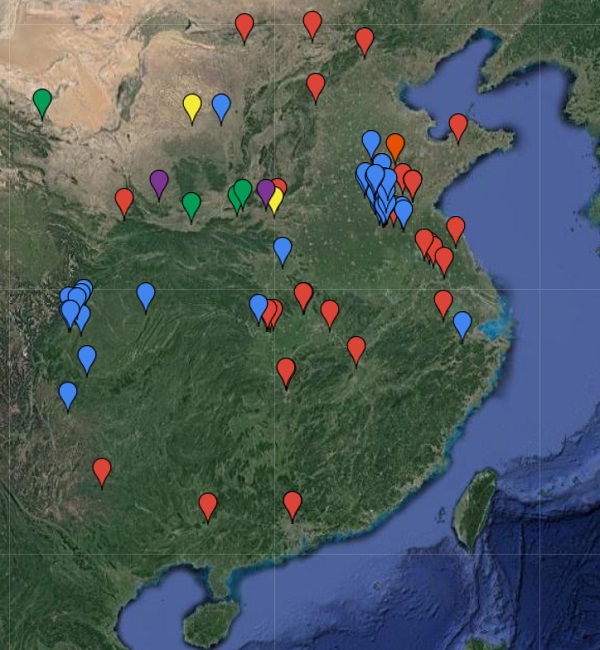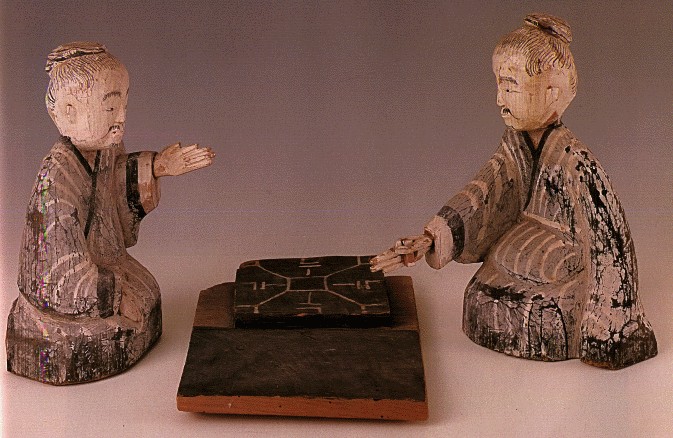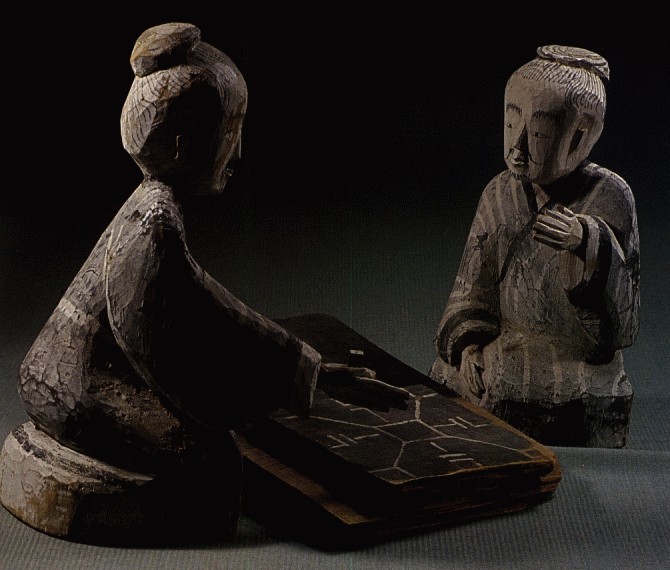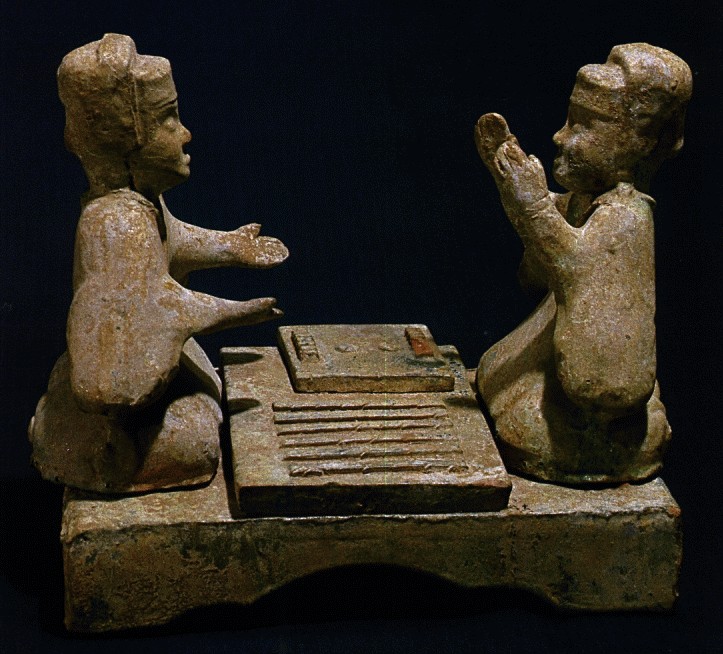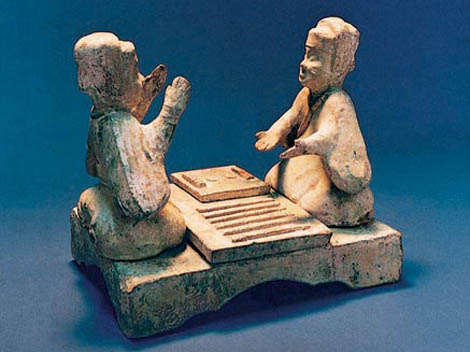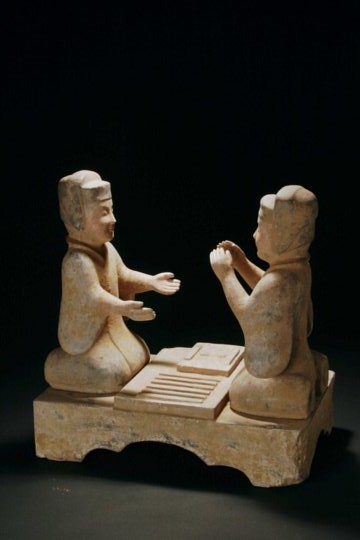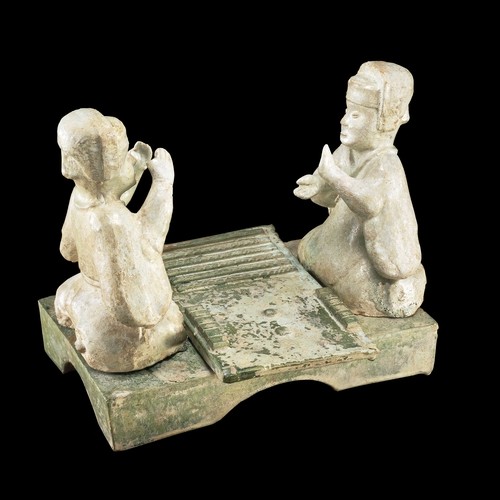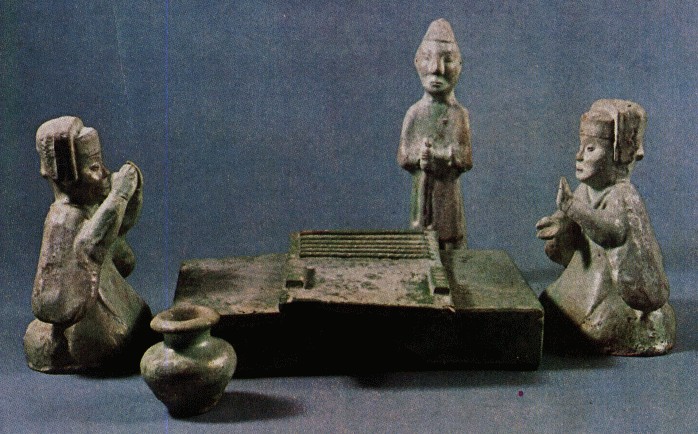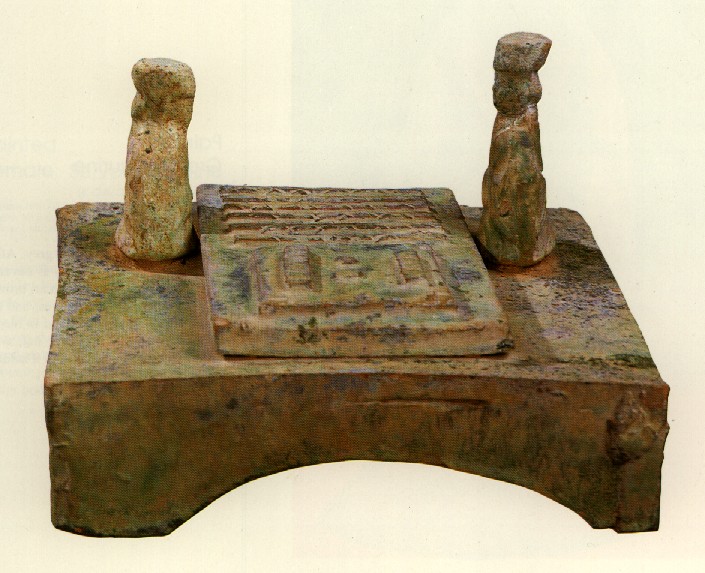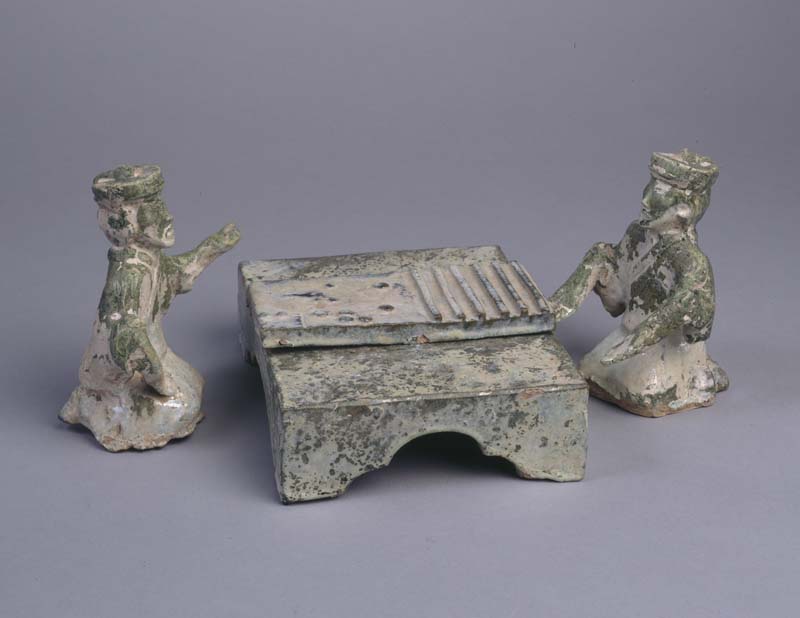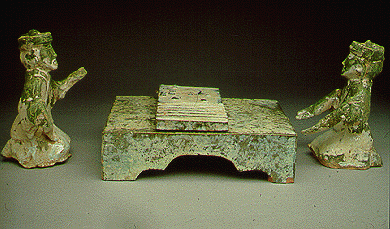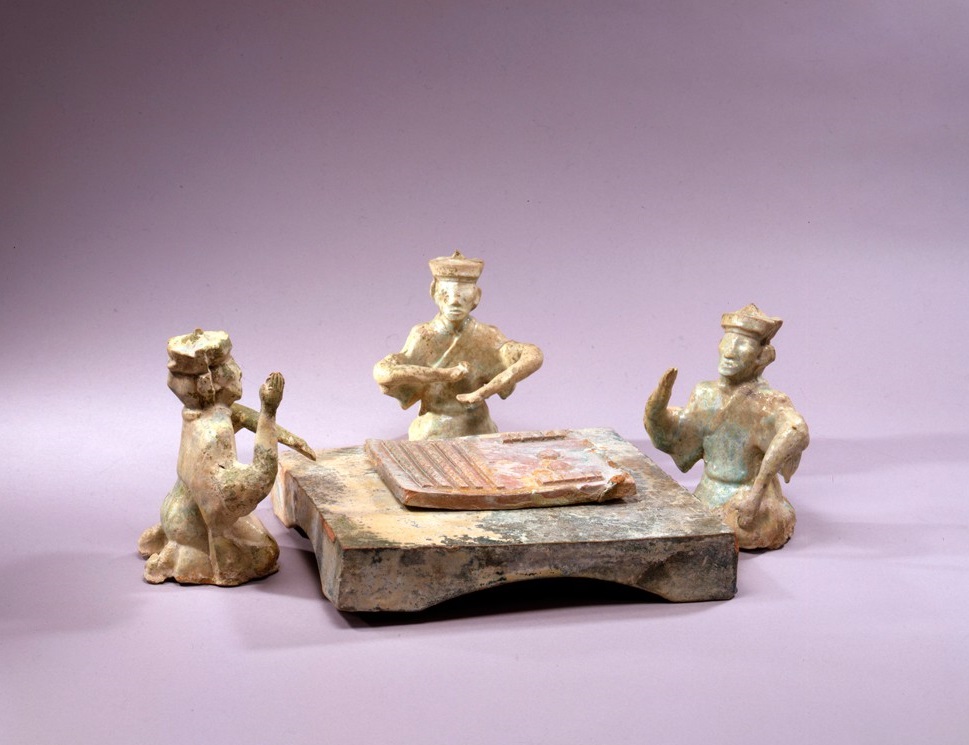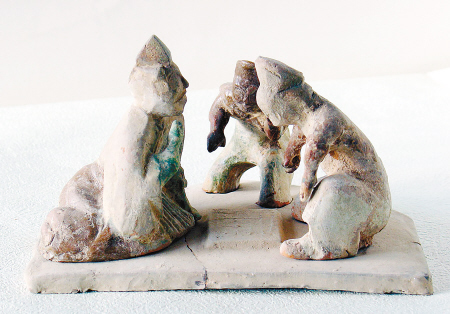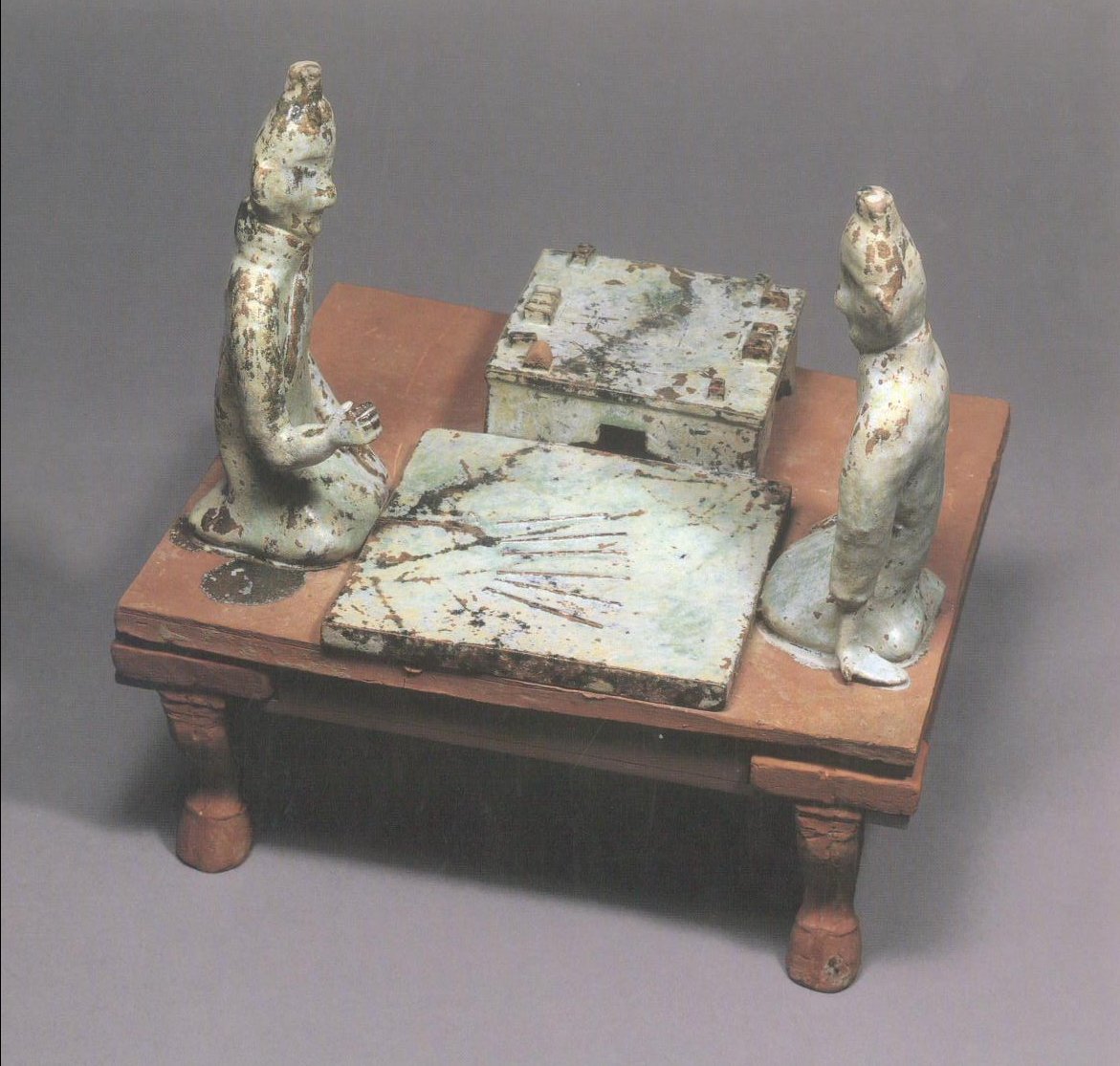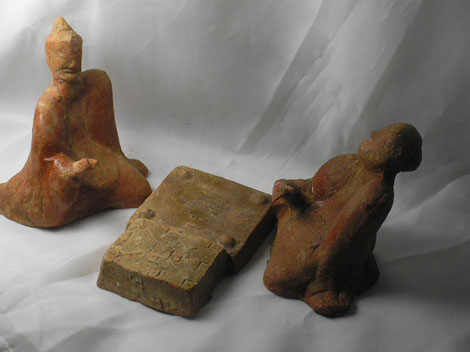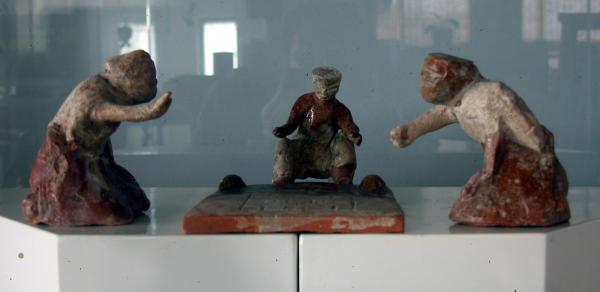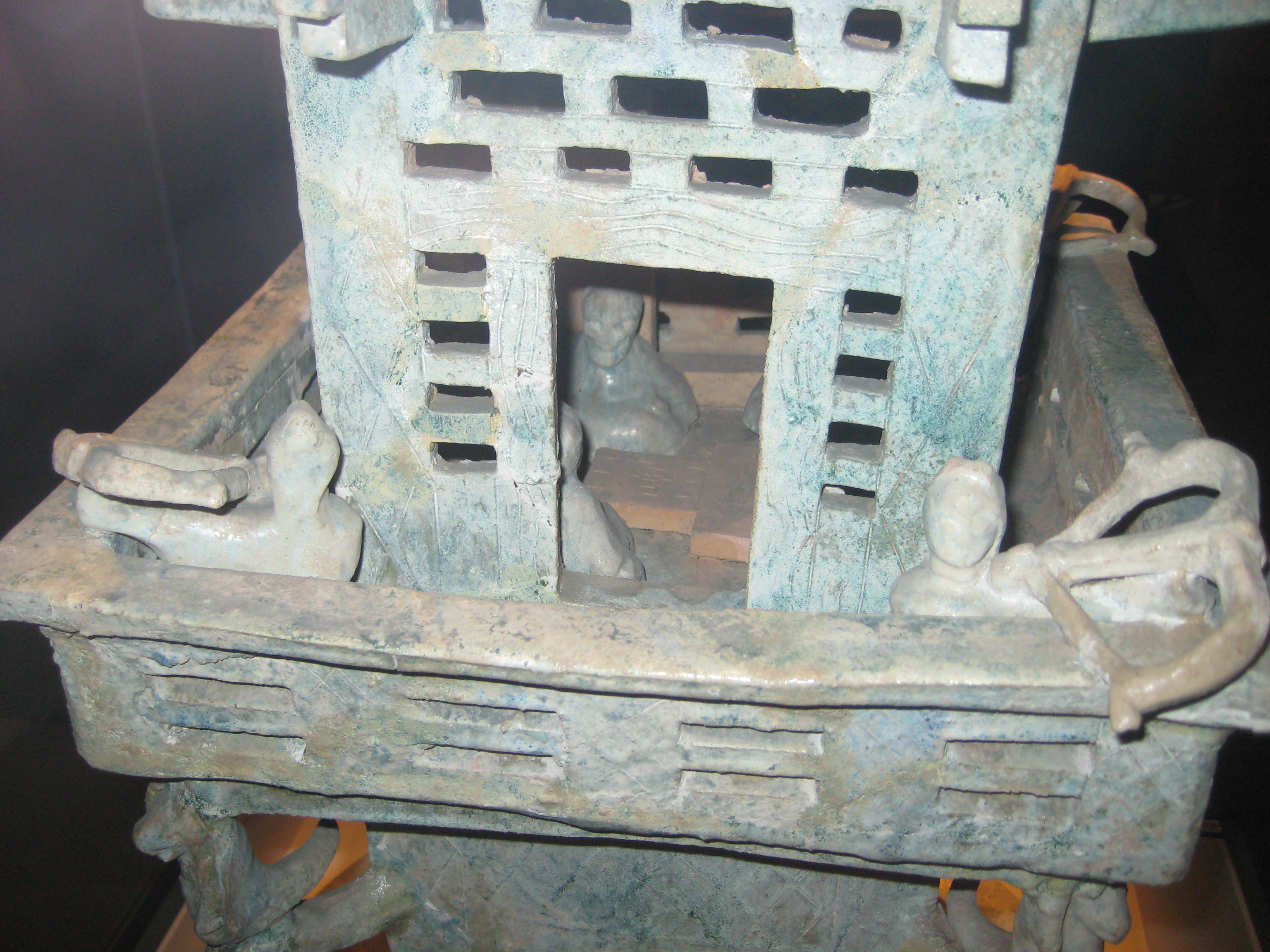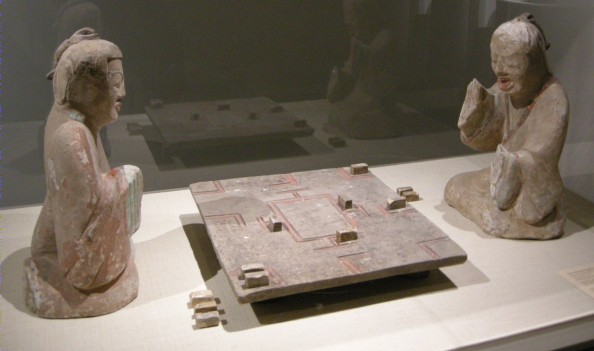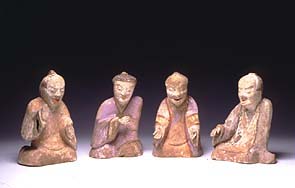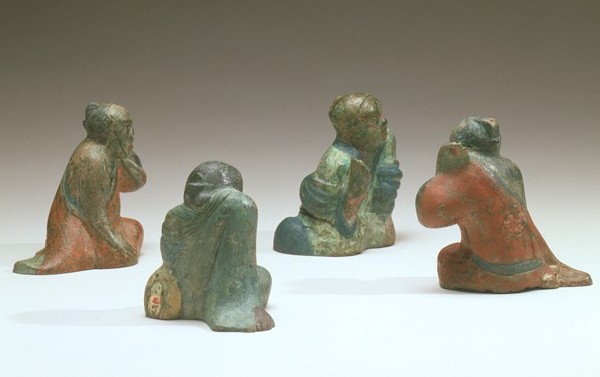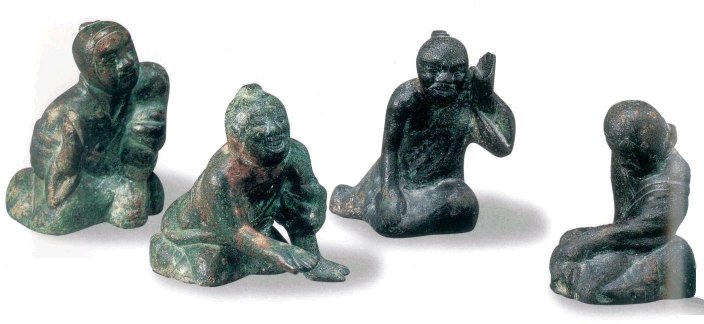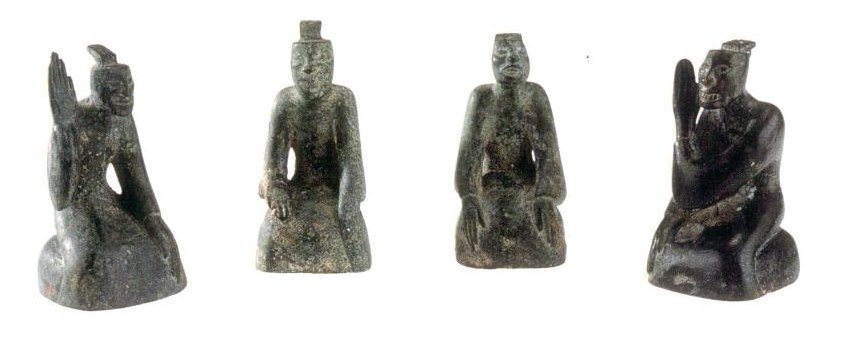BabelStone Blog
Sunday, 10 May 2009
The Lost Game of Liubo Part 1 : Funerary Statuettes
The ancient Chinese game of Liùbó 六博 or 六簙 (Old Chinese *lĭə̆uk *păk — but see Amritas for more modern reconstructions of these characters), meaning 'six sticks', was immensely popular during the latter part of the Warring States period (476–221 BCE) and throughout the Han dynasty (206 BCE – 220 CE), but later faded into oblivion. However in recent years there have been a considerable number of archaeological discoveries of the remains of Liubo boards and game equipment in tombs dating to the Warring States and Han dynasty periods, as well as a number of funerary statuettes of Liubo players, and very many depictions of Liubo players in tomb decorations from these periods. I am going to present this archaeological evidence in a series of five (or maybe more) posts :
- Part 1 : Funerary Statuettes of Liubo Players
- Part 2 : Pictures of People playing Liubo
- Part 3 : Pictures of Immortals playing Liubo
- Part 4 : Liubo Boards and Game Equipment
- Part 5 : Liubo Divination
- Part 6 : Liubo Patterns on Mirrors and Coins
- Appendix : Eighteen-Sided Dice
A Brief Introduction to the Game of Liubo
I had originally intended to present the archaeological evidence as a series of pictures with little or no interpretation or explanation, but in preparing the pictures it has become evident that I cannot do this, and will have to provide at least some sort overview of the game.
The Rules of Play
Although the exact rules of the game of Liubo are now lost, we can infer the approximate method of play from early literary sources and the archaeological evidence (and at least one person has attempted to reconstruct playable rules). However, it is not always easy to reconcile the different conflicting and fragmentary accounts of the game, and many of the precise details of play are still rather uncertain. What we do know for certain is that the game was played by two players who sat opposite each other, typically with a mat or plain board between them and a game board with a distinctive 'TLV' pattern to the side of the mat (in most of the reconstructed museum poses shown below the players are incorrectly placed facing each other over the game board rather than the stick-casting area as is shown in all contemporary depictions of the game). As can be seen from the board in Picture 1.1 the four corners and four edge mid-points of the board are marked with a right-angled mark, and the four mid-points of the centre square are marked with a T-shaped mark (twelve points in total); additionally the four mid-corner points are almost always marked with a circular mark or a pattern or a line joining the corner of the centre square to the outer corner mark. The players took turns to move six black or six white cubic or cuboid game pieces known as qí 棊 or 棋 around the twelve marked points of the board. The players' moves were determined by throwing six long, two-sided sticks known as bó 簙 onto the mat, and counting the number and/or sequence of face-up and face-down sticks. As can be seen from most of the pictures below, the game starts with the six game pieces of each player lined up neatly on the player's side of the board, and the six throwing sticks lined up neatly in the throwing area. However, in Picture 1.11 the six throwing sticks are splayed out as if they have just been thrown, and two of each player's game pieces have been moved out of line and onto the playing area of the board; and so it would seem that pieces were moved onto the board one at a time according to the throw of the sticks.
The casting of six 'sticks' in order to determine the players' moves is more than a little reminiscent of the practice of casting dried yarrow stalks in Yi Jing divination, and it may well have been that the pattern of upsides and downsides of the six sticks cast by each player would be interpretted as one of the sixty-four hexagrams (䷀䷁䷂䷃...䷼䷽䷾䷿) in order to determine (in some unknown manner) the movement of game pieces onto and/or about the board.
Liubo is generally assumed to have been some sort of race game, with players progressing their pieces systematically around the board, although this is not absolutely certain, and it could have incorporated elements found in games of skill such as Draughts or Nine Men's Morris (compare in particular the similarity with respect to board pattern and game pieces between Liubo and the Six Men's Morris variant of Merrills that has a sixteen-point board with six men on each side). Indeed, it is difficult to imagine that Liubo could have achieved such great popularity over several hundred years if it was simply a race game with the outcome determined by the luck of the throw. One possibility is that the throwing sticks were only used during the entry phase of the game to determine when and how the pieces were moved onto the board; and once on the board the players could move the pieces freely according to unknown rules of movement.
There are several specific references to and descriptions of Liubo-playing in Han and pre-Han sources which can help us understand more about the rules of play, but these are sometimes confusing and contradictory, which may be because there were different variants of the game played at different times and/or in different regions. For example, according to Yanshi Jiaxun 颜氏家训, which was written during the Northern Qi dynasty (550–577), there were two variants of Liubo, 'Greater Bo' 大博 which used six throwing sticks, and 'Lesser Bo' 小博 which used two dice called qióng 煢 or 瓊 :
古為大博則六箸,小博則二煢。今無曉者。比世所行,一煢十二棋,數術淺短,不足可翫。
The ancient Greater Bo used six sticks, whereas Lesser Bo used two dice. Nowadays there is no-one who knows how to play, but in those days when it was played it used one die and twelve game pieces. It had very little skill, and was not worth playing.
However, this is a late source from a time when the game was no longer played (at least as far as the author knew), and so should not be relied on. In the discussion below I do not distinguish between the supposed Greater and Lesser versions of the game.
One of the earliest and most interesting descriptions of the game occurs in the song Zhao Hun 招魂 "Summons of the Soul", which is found in the Chu Ci 楚辭 anthology of songs (better known in English as the Songs of the South) that were written in the region of the Chu state during the Warring States period. In describing the delights of the world of the living in order to tempt the wandering soul back to life, the poet writes that after the banquet is over :
菎蔽象棊,有六簙些。
分曹並進,遒相迫些。
成梟而牟,呼五白些。Then with bamboo dice and ivory pieces the game of Liu Bo is begun;
Sides are taken; they advance together; keenly they threaten each other.
Pieces are kinged and the scoring doubled. Shouts of ‘five white!’ arise.David Hawkes, The Songs of the South (Penguin Books, 1985) page 229.
Like most of the Chu Ci, these lines are not easy to fully understand, being written in a dialect of Chinese that is very different to that in which most classical Chinese literature is written. It is beyond the scope of this post to explicate each word of these lines, but one particular point of interest is the fact that the throwing sticks are here called bì 蔽 (Old Chinese *pĭāt) rather than bó 簙 (Old Chinese *păk). These two characters are unlikely to be cognate, and probably reflect a regional difference in the material originally used to make the throwing sticks (according to the Fang Yan 方言 by Yang Xiong 揚雄 (53 BCE – 18 CE) bó 簙 is the name used in the regions of Qin 秦 and Jin 晉, whereas bì 蔽 is the name used in the regions of Wu 吳 and Chu 楚), the bì 蔽 originally being made from the stalk of a plant, and the bó 簙 originally being made from bamboo.
One aspect of the game not yet touched upon that is mentioned in the song is the existence of a special game piece called a xiāo 梟 'owl', which may either have been a particular game piece (perhaps larger than the ordinary game pieces, or, according to one source, marked with a picture of an owl) or else may have been an ordinary piece that was promoted to an 'owl' under certain circumstances ("Pieces are kinged" in the English translation above, corresponding to the Chinese 成梟, literally "becomes an owl"). Apparently the 'owl' piece was the strongest piece, and the game would be lost if the 'owl' was taken. The lesser pieces were known as the five 'scattered' (sǎn 散) pieces. The Strategies of the Warring States 戰國策 (Strategies of Chu 楚策 chapter 3) discusses the relationship between these two types of game piece :
夫梟棊之所以能為者,以散棊佐之也。夫一梟之不勝五散亦明矣。今君何不為天下梟,而令臣等為散乎?
The reason why the owl piece is able to do what it does is that it has the scattered pieces to support it. It is clear that one owl alone cannot defeat five scattered pieces. Now, why don't you my lord act as the owl in this world, and command us your ministers to act as your scattered pieces?
It is clear from this description that the owl and the five scattered pieces are the game pieces (qí 棊) that move around the Liubo board, but in later (probably less reliable) sources the 'owl' is described as being the name of a particular throw of the sticks or throw of the dice, which wins the game (of course it is possible that the post-Han rules of Liubo were significantly different from the earlier rules, and so an 'owl' meant different things at different times). In the following story about Xie Ai 謝艾 (?–354), who was a general under the Former Liang dynasty (320–376) which ruled an area of northwest China corresponding to parts of modern Gansu, Ningxia, Shaanxi, Qinghai and Xinjiang (i.e. an area which was inhabited by predominantly non-Chinese ethnic groups), it is ambiguous as to whether the 'owl' refers to a game piece or to a throw of the sticks. According to the Book of Jin 晉書 (chapter 56), one night when Xie Ai was preparing to attack the enemy the next day, two owls perched on his tent and hooted. This would normally be taken as an ill omen (because the owl was believed to be an 'unfilial bird' that ate its mother), but Xie Ai used Liubo to interpret this as an auspicious omen :
梟,邀也,六博得梟者勝。今梟鳴牙中,克敵之兆。
An owl is an ace (reading 邀 yāo "invitation" as 幺 yāo "one", the name of the best throw according to one source) ; in the game of Liubo whoever gets the 'owl' wins the game. So now an owl hooting on my tent is a sign that I will defeat the enemy.
The fullest extant description of the rules of play occur in a quotation from the lost Book of Ancient Bo 古博經 in a commentary to the Book of Liezi 列子 by the Jin dynasty (265–420) writer Zhang Chen 張湛 :
博法:二人相對坐,向局,局分為十二道,兩頭,當中名為水。用棋十二枚,古法六白、六黑。又用魚二枚,置於水中。其擲采以瓊為之。二人互擲彩行棋,棋行到處即竪之,名為驍棋。即入水食魚,亦名牽魚。每牽一魚獲二籌,翻一魚獲三籌。若已牽兩魚而不勝者,名曰被翻雙魚,彼家獲六籌為大勝也。
Method of play : Two people sit facing each other over a board, and the board is divided into twelve paths, with two ends, and an area called the 'water' in the middle. Twelve game pieces are used, which according to the ancient rules are six white and six black. There are also two 'fish' pieces, which are placed in the water. The players throw dice called qióng. The two players take turns to throw the dice and move their pieces. When a piece has been moved to a certain place it is stood up on end, and called a 'fierce' piece. Thereupon it can enter the water and eat a fish, which is also called 'pulling a fish'. Every time a player pulls a fish he gets two tokens, and if he pulls two fish in a row he gets three tokens [for the second fish]. If a player has already pulled two fish but does not win it is called double-pulling a pair of fish. When one player wins six tokens the game is won.
There are a number of points of interest in this passage.
Firstly, the piece that here is called a 'fierce' piece is the same as the 'owl' piece mentioned elsewhere, as the character xiāo 驍 'fierce' is a homphone for (and probably cognate with) the character xiāo 梟 'owl'. This passage lends support to the notion that the 'owl' is a promoted ordinary piece rather than a special piece in its own right, and is consistent with the line "becomes an owl and doubles" (成梟而牟) in the "Summons of the Soul". The character móu 牟 in this line originally meant to moo (of a cow), but is glossed by Wang Yi 王逸 as meaning "to double" in this context. This character probably corresponds to the expression "double-pulling a pair of fish" (被翻雙魚) given above, and indicates that only once a piece has been promoted to an owl can it make a 'double' play.
Secondly, the two fish pieces that are placed in the centre of the board must be the two round pieces in the centre of most of the pottery Liubo boards shown below (e.g. Picture 1.2). However, as we shall see later, excavated Liubo sets often include two sets of six game pieces, but rarely if ever include two round 'fish' pieces, so perhaps the 'fish' are only a feature of one particular variant of the game played during the Eastern Han period.
Thirdly, the game is scored using tokens, which accords with archaeological evidence, as bundles of thin tally sticks (chóu 籌) are often found near or together with funerary Liubo sets.
Finally, it should be mentioned that although the character qióng 煢 or 瓊 is normally glossed as a type of dice, it is not certain that it is actually a multi-faced die, and it may just be a later name for the throwing sticks (bó 簙).
The Origins and Demise of Liubo
The origins of the game are unknown, although according to the earliest Chinese dictionary, Shuowen Jiezi 說文解字, compiled about 100 CE by Xu Shen 許慎, the game was devised by Wu Zhou 烏胄 (called Wu Cao 烏曹 in other sources) who was supposedly a minister to King Jie, the last king of the Xia dynasty (traditionally dated to 2205–1766 BC) :
簙:局戲也,六箸十二棊也。从竹博聲。古者烏胄作簙。
[Liu]bo : a board game, played with six throwing sticks and twelve game pieces. The character bó has the bamboo radical with the character bó as a phonetic. The game [Liu]bo was created in ancient times by Wu Zhou.
However, there is no archaeological evidence or reliable documentary evidence to indicate that Liubo was in existence earlier than the Zhou dynasty (1045–256 BC). From an archaeological perspective the game seems to have been most popular during the Han dynasty, and during the pre-Han period in the State of Chu, but as far as I am aware (and I have spent many hours looking) no examples of Liubo game equipment or any depictions of the game have ever been found in archaeological contexts predating the Warring States period (476–221 BCE). This may be because the game was not devised until sometime after about 500 BCE, but it may also be that Liubo boards were not considered suitable grave goods in earlier times—and Western Zhou and Shang Dynasty funerary assemblages are very different to those of the Warring States and Han periods.
Whatever its origins, after several hundred years of phenomenal popularity the game of Liubo falls dramatically out of favour soon after the end of the Han dynasty, it's demise coinciding with the rise in popularity of the more skillful game of Wéiqí 圍棋 (more commonly known in English as Go). However, although there are no known examples of Liubo funerary ware or depictions of Liubo playing later than the Jin dynasty (265–420), the game continues to be mentioned occasionally in historical sources for several hundred years more, and a version of the game may still have been played to some extent as late as the Tang dynasty (618–907), and even into the early Song dynasty (960–1279).
For example, the Old Book of Tang 舊唐書 chapter 146A mentions that Tibetans enjoyed playing both Weiqi (Go) and Liubo (圍棋陸博). Although there is no other evidence for Tibetan Liubo, there is archaeological and documentary evidence that Go was played in Tibet at an early date, and it may well be that in the same way that the archaic 17×17 Go board was preserved in Tibet when the 19×19 board had become standard in China, so too was the archaic game of Liubo preserved in Tibet when it was no more than a fading memory in China. The only other mention of the game of Liubo in the Book of Tang occurs in chapter 111, which tells the story of how commanding general Han Hong 韓弘 (765–823) tried to subvert the military prowess of his subordinant, General Li Guangyan 李光顏 (761–826), by sending him a beautiful girl skilled in the arts of "song, dance, music and Liubo" (歌舞弦管六博之藝) who he vainly hoped would distract his rival from martial activities. I think that it is not a coincidence that Li Guangyan (original name Adie Guangyan 阿跌光顏) was not an ethnic Chinese, but a member of a Uyghur tribe from the Ordos Desert region. If, as I believe, by the Tang dyansty Liubo was no longer played in China proper, but was restricted to peripheral regions, it may well have been a popular pastime among Uyghurs as well as among Tibetans, and so Han Hong would have deliberately selected a Uyghur girl who had been trained in Uyghur arts—including Liubo. This would explain why the Book of Tang only mentions this single specific case of someone being skilled in playing Liubo, whereas it mentions many examples of people who were specifically skilled in the game of Go.
The game of Liubo is also mentioned once in the History of the Five Dynasties 五代史 (covering the period 907–960, between the Tang and Song dynasties), in relation to Liu Min 劉旻 [originally called Liu Chong 劉崇] (895–954), who was a member of the Shatuo Turk tribe and the founder of the short-lived Northern Han 北漢 kingdom (951–979). As a youth Liu Min was said to have been a wastrel who liked to play Liubo and gambling games. This further strengthens the argument that by this time Liubo was only played by members of non-Chinese ethnic groups.
Map of Sites of Liubo Discoveries
Distribution of sites of Liubo discoveries (12 April 2022)
(Click on map to open Google Maps in a new tab)
Key
- Red = Liubo boards and game equipment
- Blue = Picture stones and picture bricks (Humans | Immortals)
- Green = Funerary statuettes of Liubo players
- Yellow = Murals and paintings
- Purple = Liubo figure mat weights
1. Liubo Figurines with a Game Board
Most funerary sets of Liubo figurines are made from green-glazed pottery and comprise two players and a board with the playing pieces apparently laid out in the initial position : six throwing sticks laid out in parallel on the throwing area between the two players, six cubic game pieces laid out neatly in a row on each side of the board, and two round counters (the 'fish') placed in the middle of the board. The distinctive board pattern is normally faint or invisible in these examples, but it is exceptionally clear in the beautiful painted wooden board (Picture 1.1), which is also probably the earliest extant example of Liubo-playing figurines.
1.1 Painted wooden statuettes of Liubo players
甘肅武威磨咀子48號西漢墓出土彩繪木雕對弈六博俑
Source : Wenwu 文物 1972.12
Source : Zhongguo Meishu Quanji 中國美術全集‧雕塑編 (Beijing, 1988) vol.2 plate 68
Provenance : Tomb M48 at Mozuizi, Wuwei, Gansu. {37.786°N 102.650°E}
Current Location : Gansu Provincial Museum, Lanzhou.
Date : Late Western Han (206 BCE – 25 CE)
Size : Figures 28.0 –29.0 cm. in height
Notes : The figure on the right is holding a cuboid game piece between the thumb and forefinger of his right hand.
References : 《武威磨咀子三座漢墓發掘簡報》 (《文物》1972.12).
1.2 Green-glazed pottery statuettes of Liubo players
河南靈寶縣張灣村三號東漢墓出土綠釉陶對弈六博俑
Source : Zhongguo Meishu Quanji 中國美術全集‧雕塑編 (Beijing, 1988) vol.2 plate 120
Source : The green-glazed liubo-playing pottery figurines (cultural China)
Provenance : Tomb M3 at Zhangwan Village, Lingbao, Henan {34.494°N 110.888°E}.
Current Location : Henan Museum, Zhengzhou.
Date : Late Eastern Han (25–220)
Size : 28.0 × 19.2 cm. and 24.2 cm. in height
References : 《靈寶張灣漢墓》 (《文物》1975.11).
1.3 Unglazed pottery statuettes of Liubo players
弗蘭克爾美術館藏陶對弈六博俑
Source : Gray Pottery Figures of Two Gentlemen Playing Liubo (E&J Frankel, Ltd.)
Provenance : Xi’an, Shaanxi. {34.25°N 108.97°E}
Current Location : E&J Frankel, Ltd., New York.
Date : Western Han (206 BCE – 25 CE) [thermoluminescence tested]
Size : 38.9 × 24.6 cm. and 38 cm. in height
1.4 Green-glazed pottery statuettes of Liubo players
大英博物館藏綠釉陶對弈六博俑
Source : Ceramic Liubo players (The British Museum)
Source : Chinese Pottery and Porcelain (London, 1991)
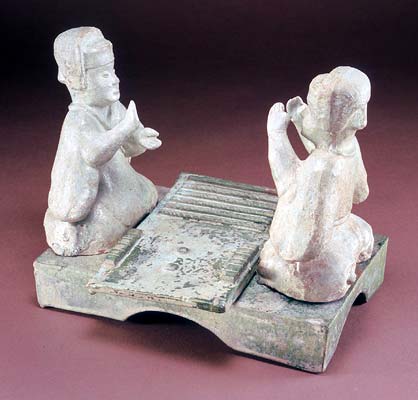
Source : Games of Chance (Asian Games: the Art of Contest)
Provenance : Unknown.
Current Location : British Museum, London [Asia OA 1933.11-14.1].
Date : Eastern Han (25–220)
Size : 12 × 15 cm. and 25.6 cm. in height
1.5 Green-glazed pottery statuettes of Liubo players
台灣國立歷史博物館藏綠釉陶對弈六博俑
Source : Taoyong – Nisu de Yongheng Yishu 陶俑—泥塑的永恆藝術 (Taibei, 1988) plate 3
Provenance : Unknown.
Current Location : National Museum of History, Taibei.
Date : Eastern Han (25–220)
Size : 23.6 × 24.2 cm. and figures 8.0 cm. in height
1.6 Green-glazed red pottery statuettes of Liubo players
綠釉陶對弈六博俑
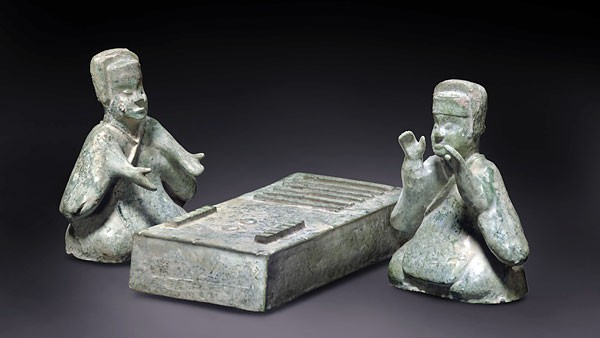
Source : A rare group of two green-glazed red pottery figures of Liubo players and a rectangular gaming table (Les cahiers d'Alain Truong)
Provenance : Unknown.
Current Location : Private collection. Sold for $277,500 at Christie's Fine Chinese Ceramics and Works of Art at New York on 2008-03-19 (Sale 1976 Lot 504).
Date : Eastern Han (25–220)
Size : Unknown.
1.7 Grey pottery statuettes of Liubo players
陶對弈六博俑
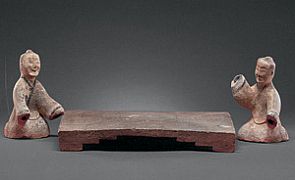
Source : A set of grey pottery 'Liubo' players and board (藏点)
Provenance : Unknown.
Current Location : Private collection. Sold at auction in 2005.
Date : Eastern Han (25–220)
Size : 36.8 × 32.4 cm. and figures 19.0 and 20.3 cm. in height
1.8 Earthenware statuettes of Liubo players
安大略皇家博物館藏陶對弈六博俑
Source : Earthenware liubo-playing burial figures (Royal Ontario Museum)
Source : The Ancient Uses of Rhinoceros Horn (Chinese Unicorn)
Provenance : Unknown.
Current Location : Royal Ontario Museum, Toronto [ROM2005_3845_1].
Date : Eastern Han (25–220)
Size : Unknown.
1.9 Green-glazed pottery statuettes of Liubo players
賽克勒考古與藝術博物館藏綠釉陶對弈六博俑
Source : Three Capped Men Kneeling around a Low Table and Playing Liubo
(Harvard Art Museums/Arthur M. Sackler Museum, Gift of Anthony M. Solomon)
Provenance : From the collection of Anthony M. Solomon (1919–2008)
Current Location : Arthur M. Sackler Museum at Harvard University, Cambridge [2003.174].
Date : Eastern Han (25–220)
Size : 26.5 × 23.5 cm. (board 16.0 × 12.0 cm.) and figures 17.0 cm. in height
1.10 Green-glazed pottery statuettes of Liubo players
私人藏綠釉陶對弈六博俑
Source : 難得一見的漢代六博俑 (中國經濟網)
Provenance : Unknown.
Current Location : Private collection.
Date : Eastern Han (25–220)
Size : 20.0 × 16.5 cm. and figures 8.6, 9.8 and 11.0 cm. in height
1.11 Green-glazed red pottery statuettes of Liubo players
綠釉陶對弈六博俑
Source : Liubo (Jean-Louis Cazaux)
Provenance : Unknown.
Current Location : Unknown.
Date : Eastern Han (25–220)
Size : Unknown.
1.12 Red pottery statuettes of Liubo players
陶對弈六博俑
Source : Kaleidoscope: Liubo (cultural China)
Provenance : Unknown.
Current Location : Unknown.
Date : Eastern Han (25–220)
Size : Unknown.
1.13 Red pottery statuettes of Liubo players
陶對弈六博俑
Source : 六博俑 (Hudong 互动百科)
Provenance : Unknown
Current Location : Unknown.
Date : Eastern Han (25–220)
Size : Unknown.
1.14 Green-glazed pottery model three-storied house with Liubo players inside
河南陝縣劉家渠73號東漢墓出土綠釉陶樓閣裏的對弈六博俑
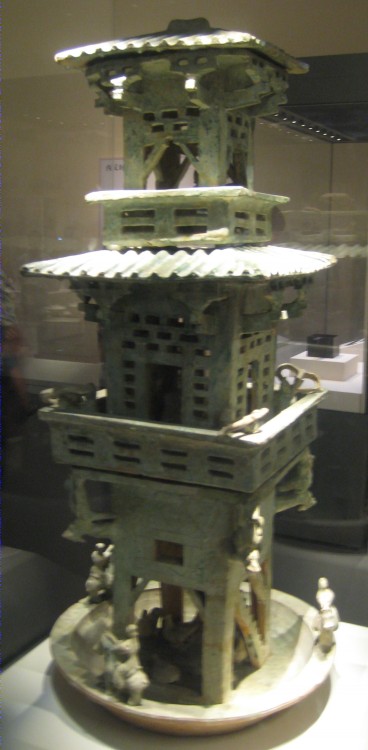
Green-glazed pottery model three-storied house (cf. Kaogu Xuebao 考古学报 1965.1 plate V no.3)
Liubo players inside a green-glazed pottery model three-storied house (cf. Kaogu Xuebao 考古学报 1965.1 plate V no.4)
CC-BY-SA-3.0 by Andrew West
Provenance : Tomb M73 at Liujiaqu, Shan County, Henan. {34.713°N 111.185°E}
Current Location : National Museum of China, Beijing.
Date : Early Eastern Han (25–220)
Size : House 98.7 cm. in height
Notes : Other examples of the same type of model house were found in tombs M20 and M34.
2. Liubo Figurines with No Board
In addition to pairs of figurines with a Liubo board and game eqipment, a number of figurines in isolation are known. In some cases, such as Picture 2.1, the figures may originally have belonged to a complete set, but either the board had decayed before the tomb had been excavated, or (perhaps more likely given that the board and players are usually made of the same material) they come from a robbed tomb, and the set was broken up for sale as individual items.
On the other hand, the sets of four small bronze figurines shown here (and I believe that several other sets are known) are thought to have been used as mat weights (one at each corner of the mat), and would not have come with a game board and equipment. In fact, it is difficult to be certain that they do in fact represent Liubo players, and I only include them as they are commonly described as Liubo figurines. (The more I look at them the less they look like Liubo players to me, as they show none of the lively gesturing and stick-throwing movements of the arms that we see in the Liubo figurines with a board or the images of Liubo players on Han picture stones.)
2.1 Earthenware statuettes of Liubo players
大都會博物館藏陶六博俑
Source : Wikimedia (CC BY/SA by Sailko)
Provenance : Unknown.
Current Location : Metropolitan Museum of Art, New York [1992.165.23].
Date : Eastern Han (25–220)
Size : 36.2 cm. in height
Notes : The board is from a different tomb than the figurines (and it is not even certain that the figurines are Liubo players).
2.2 Four earthenware statuettes of Liubo players
弗吉尼亞美術館藏陶六博俑
Source : Burial Figures and Models (Virginia Museum of Fine Arts)
Provenance : Unknown.
Current Location : Virginia Museum of Fine Arts, Richmond [99.39.1-4].
Date : Eastern Han (25–220)
Size : About 30 cm. in height
Notes : Audio description by Daphne Maxwell Reid (text version).
2.3 Four painted bronze statuettes of Liubo players
加德納博物館藏铜六博俑
Source : Liubo Players (A Bronze Menagerie: Mat Weights of Early China)
Provenance : Unknown.
Current Location : Isabella Stewart Gardner Museum, Boston.
Date : Western Han (206 BCE – 25 CE)
Size :2.8 – 3.2 cm. in height
2.4 Four bronze statuettes of Liubo players
甘肅靈臺西漢墓出土一組青銅4人六博俑
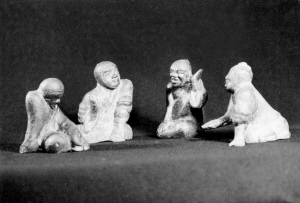
Source : 汉代六博俑 (人民日报海外版)
Source : Liubo (Jean-Louis Cazaux)
Provenance : A tomb at Lingtai, Gansu. {35.06°N 107.62°E}
Current Location : Gansu Provincial Museum, Lanzhou.
Date : Western Han (206 BCE – 25 CE)
Size : 7.9 – 9.2 cm. in height
2.5 Four bronze statuettes of Liubo players
广西西林县普驮屯铜鼓墓出土一组青铜4人六博俑
Source : Archéologie chinoise, trésor de la Région du Guangxi (Paris, 2003) page 91
Provenance : Bronze drum tomb at Putuo Tun, Xilin, Guangxi. {24.44°N 105.19°E}
Current Location : Guangxi Museum, Nanning.
Date : Western Han (206 BCE – 25 CE)
Size : Unknown.
2.6 Four bronze statuettes of Liubo players
河南新安出土一组青铜4人六博俑
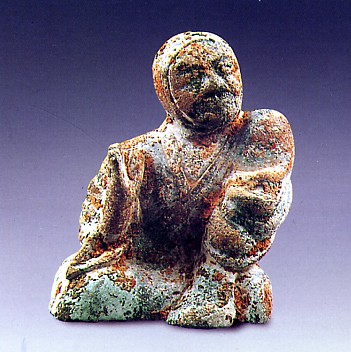
Source : Wenwu 文物 2005.08 front cover
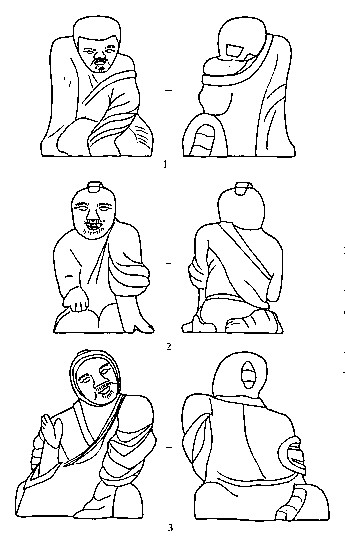
Source : Wenwu 文物 2005.08 page 95
Provenance : A tomb at Xin'an, Henan. {34.73°N 112.13°E}
Current Location : Unknown.
Date : Western Han (206 BCE – 25 CE) ?
Size : 7.5, 8.2 and 9.0 cm.
Notes : Four bronze statuettes in three styles were found in an otherwise looted tomb. There were two examples of the third style (that shown in the colour picture, and the bottom drawing).
Last updated: 2022-04-12.
Index of BabelStone Blog Posts
